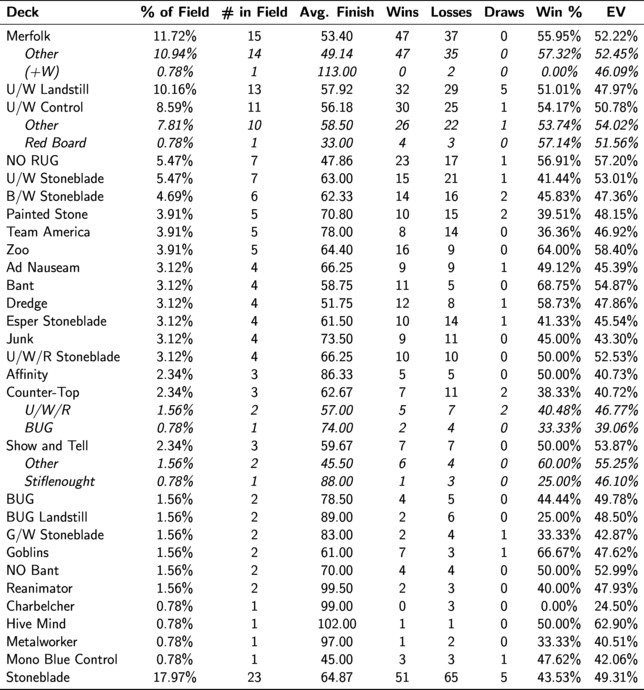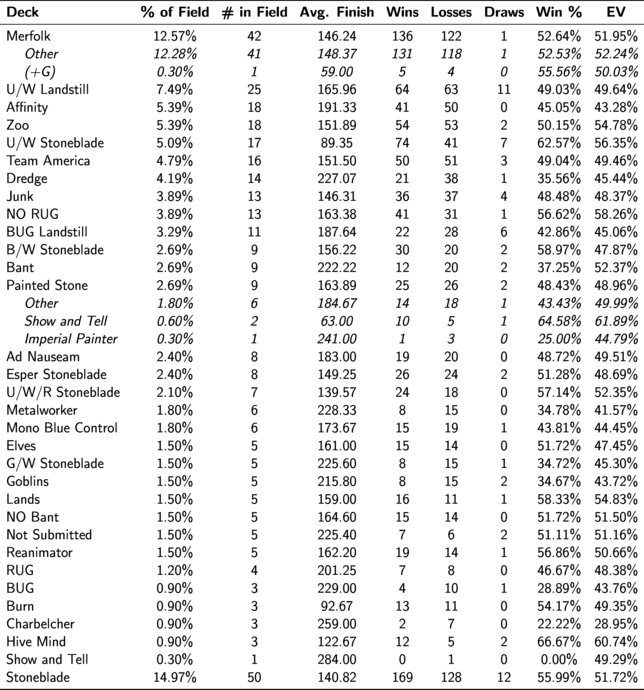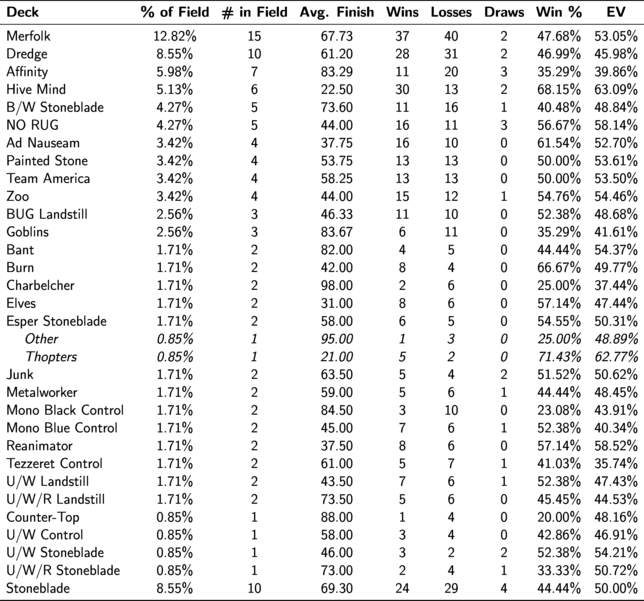Welcome back! Last time, we analyzed the results of Grand Prix Providence, and now we’ll get a glimpse at how that event has begun to influence the
format. This time, we’ll be looking at three tournaments, including the largest Legacy Open yet. We’ll also get to look at the first Invitational to
feature Legacy, as well as the Open Series’ return to Denver, Colorado. Download the spreadsheet to get the raw data from all three events.
Invitational Breakdown (Legacy Portion)

The Invitational, with its 128 participants who have all had their share of success in the Open Series, presents us with an unusual dataset. The
metagame is probably not representative of a typical field in an Open event, but it does show us trends among a subset of regular players.
The first thing to take note of is that Merfolk was a smaller portion of the field than it had been in recent events, including Grand Prix Providence.
It was still the most popular deck, and it performed very well. U/W Landstill was nearly as popular as Merfolk, with U/W Control not far behind. NO RUG
showed up in respectable strength and was very successful. U/W Stoneblade was as popular as NO RUG, and its presence combines with that of U/W
Landstilll and U/W Control to make U/W Jace decks a hefty slice of the metagame. Stoneblade was the worst performer out of the three decks.
Indianapolis Legacy Open Breakdown

With 334 participants, the Indianapolis Legacy Open was the largest Legacy Open to date. Its field breakdown gives us a much better picture of the
format, post-Providence.
While Merfolk and Landstill were again the most popular decks, the gap between their field percentages was noticeably larger. The next most popular
decks were Affinity and Zoo, which were much less popular in the Invitational.
The best performer was U/W Stoneblade, in contrast with its poor record in the Invitational. NO RUG and B/W Stoneblade also did exceptionally well.
Note that NO RUG also has one of the highest EVs, second only to Hive Mind.
Other interesting results include dismal performances by Bant and Dredge, which were two of the most successful decks in Providence.
Denver Legacy Open Breakdown

The Denver Legacy Open is the smallest tournament we’re examining this time, and its field was so spread out that we have very little data for most
individual archetypes.
Of the four decks that made up at least 5% of the field, Hive Mind is the only one to post a positive win percentage (and a very high one, at that).
This marks the first event since the release of New Phyrexia at which Merfolk failed to win more than half of its matches. The fact that its EV was
still high suggests that it may actually have been a good choice in Denver and that its negative record was the result of variance.
This time, the second-most popular deck was Dredge, which had five times as many players as U/W Landstill, which was the second-most popular deck in
the other two tournaments.
NO RUG, once again, performed very well. The few Ad Nauseam players in the tournament also posted a high win percentage.
This time, we’ll be looking at matchups for decks that were at least 5% of the field in the Indianapolis Open. Because the other two events were so
much smaller, the matchup data we have for other decks is insufficient for in-depth analysis.
Merfolk – 12.44% of Field – Won 52.37% of Matches
Example: Scott Mui, 3rd Place – Indianapolis Legacy Open

Merfolk, while still performing reasonably, did worse in these events than it did at Grand Prix Providence. Looking at how it matches up against the
other popular decks gives us a hint as to why: three out of the four matchups are unfavorable, and one of them extremely so. The Affinity matchup,
however, appears to be very favorable.
The fact that U/W Landstill and U/W Stoneblade are having some success against Merfolk probably helps explain their popularity. Traditionally,
blue-based control decks struggle against the fish, but it seems that the adoption of Stoneforge Mystic, Wrath of God, and other tools has helped bring
about this change.
U/W Landstill – 6.91% of Field – Won 49.85% of Matches
Example: Josh Guibalt – 8th Place, Indianapolis Legacy Open

Despite its reasonable matchup against Merfolk, and its recent surge in popularity, Landstill’s win record over these three events was decidedly
mediocre. Going by the overall win percentages, we see matchups ranging from unfavorable to close. The most unfavorable of these matchups, U/W
Stoneblade, is striking, because the two decks share so many cards.
Affinity – 4.84% of Field – Won 42.96% of Matches
Example: N/A

At the Invitational, Affinity posted its best win percentage since New Phyrexia became legal, 50%. At the other two events, it did considerably worse.
Once again, we have to recommend against playing Affinity.
The Merfolk matchup is terrible, which is a big strike against any deck, and the matchups against the other popular decks don’t exactly make up for it.
Zoo – 4.66% of Field – Won 53.09% of Matches
Example: Pat Cox – 1st Place, Indianapolis Invitational

We can see here that Zoo’s historical matchups are stronger in several cases than the matchups observed in Indianapolis and Denver. This is reflected
in the fact that Zoo underperformed with respect to its EV; it did poorly in several matchups in which it’s done well in the past. These discrepancies
are probably best explained by variance due to small samples. If we trust the overall numbers, we conclude that Zoo not only beats Merfolk, but also
Affinity, and its matchups against the U/W decks are very close.
U/W Stoneblade – 4.32 % of Field – Won 57.43% of Matches
Example: Josh Rayden – 9th Place, Indianapolis Legacy Open

With strong matchups against the two most popular decks, U/W Stoneblade looks well-positioned right now. Its win percentage over these three events
backs this up, and it is by far the highest among the decks we’ve looked at in detail. Stoneblade’s matchups against Affinity and Zoo appear close, if
not quite favorable.
NO RUG and Hive Mind, though they weren’t played very much, stood out as winning decks (56.67% and 68.15%, respectively). NO RUG’s popularity has
certainly increased since the Grand Prix, and with the deck’s recent success, it may continue to do so. Hive Mind made up a significant portion of the
field in Denver, and it may soon establish itself as a consistent part of the metagame. Hopefully, as these decks see more play, we’ll have enough data
to examine them in detail soon.
Merfolk appears to be on a slight decline at the moment, possibly due to worse showings in the last few tournaments, but it’s still consistently the
most popular deck. Team America’s presence seems to have largely diminished following its lack of results at the Grand Prix. Interestingly, Bant, which
we expected to become more prevalent following its victory in Providence, has remained relatively uncommon, and those players who did choose to play it
in Indianapolis and Denver did not do well.
Instead, more players seem to be gravitating toward U/W control decks, particularly Landstill and Stoneblade. Given their slightly favorable matchups
against Merfolk, the usual foil to control, it will be interesting to see how the metagame responds. If U/W Stoneblade continues to outperform U/W
Landstill, it seems likely that Stoneforge Mystic will eventually be ubiquitous in control decks.
For now, it looks like U/W Stoneblade, NO RUG, Hive Mind, and Zoo are strong choices. These decks have all put up solid results in multiple
tournaments. Merfolk is a reasonable deck to play if you feel comfortable in the mirror and against Stoneforge Mystic decks.
Good luck in Baltimore, and we’ll see you there!
Alix Hatfield
Jesse Hatfield
